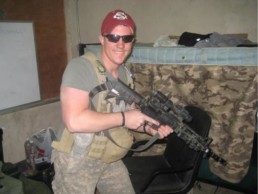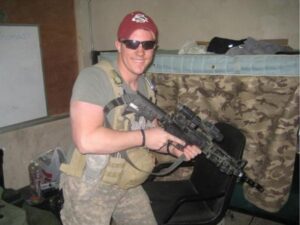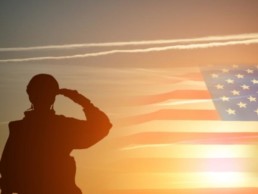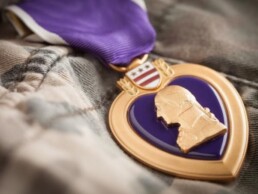Spreading Holiday Love
The spirit of giving brings us together, whether it’s giving Christmas presents under the tree or giving back in your community.
In an effort to spread holiday cheer, Purple Heart Foundation staff volunteered on Saturday, December 21, 2019 to serve a holiday meal and distribute care packages to homeless veterans at the Department of Veteran Affairs Community Resource & Referral Center, in Washington D.C., driven by the sole purpose, “to holistically enhance the quality of life of all veterans.”
It hurt to see the necessity in our own community; just think how many more homeless veterans are out there? As passionate employees of the Purple Heart Foundation that work hard to help as many veterans as possible, thoughts like this hit close to home. Our heroes deserve the very best after everything they’ve sacrificed.
Here’s what our volunteers said about their humble service on Saturday:
“It was a very positive experience. It felt really good to give back to those veterans who served” – Mitchell Theis
“The VA staff members had wonderful holiday spirit and I look forward to doing more volunteer work next year.” – Berhanu Adamu
The Purple Heart Foundation’s Marketing Manager, Amelia Kakar, said “It was very fulfilling to see all the veterans savoring the holiday meal we served, and to see their smiles as they opened our care packages. I’m also very proud of our staff who volunteered on a weekend to not only serve a holiday meal and distribute care packages but to bring hope, kindness and joy to homeless veterans who may not have been able to celebrate Christmas with family and friends this year. The experience was inspiring. My goal, as we move into a new decade, is to coordinate more experiences like this for our staff and corporate partners all over the country to work directly with their local veterans too.”
Purple Heart Foundation employee, Bianca Meruvia, has been volunteering since childhood with her mother, Luisa Meruvia, who also volunteered Saturday. Bianca said she chose a non-profit career path because “helping those in need fills my heart with joy. At one point in life I was in their position and I’m not ashamed because it made me the person I am today. I’m truly grateful for every little thing in life and everyone in it because when I needed help someone was there for me. I want them to know that I will be there for them and they’re not alone… especially at this time, which tends to be the hardest. It made me so happy to see the smiles on their faces.”
The staff enjoyed their experience giving back. Hands-on experiences such as this can be life changing for both the giver and receiver. Your support of the Purple Heart Foundation as we transition into 2020 will allow us to continue creating life changing experiences for our nation’s heroes. Donate by 11:59pm on New Years Eve USING THIS LINK, and our partners at Nexen Tire will double your donation!
Daniel Prigge: Surviving the Hits
The Purple Heart Foundation connects with Purple Heart recipients to share their unforgettable stories of valor. Here on the Purple Heart Foundation blog, you will read about the personal experiences of some of our heroes. These veterans have proudly served and sacrificed to protect our nation. Daniel Prigge is one of them…he is lucky to be alive, and proud to share his story to inspire others to keep carrying on.
“My name is Daniel Prigge, I served a little over 10 years in the US Army. I was wounded on May 03, 2011. My vehicle was struck by three EFP roadside bombs. My convoy was hit with a total of five EFP’s and one EFP that did not go off. My truck was also hit by an RPG and small arms fire during the ambush.
I was on a small fourteen-man team that was PSD (Protective Service Detail) for the general in charge of the pull out of Iraq. On May 2nd, the general took a helicopter flight to a meeting right outside of Baghdad, Iraq. The next day, my team was on the way to pick him up and bring him back to our FOB (Forward Operating Base). We were on the outskirts of Baghdad on a route that had a fence line on the left side and a canal on the right side. We were using RG33L trucks – a mine-resistant light armored vehicle built longer than the RG-33 to hold twice as many people – due to how many people we would have to escort from place to place. We were traveling down the route when suddenly I see an RPG hit the front of my truck…seconds later I felt an explosion to the left side of my vehicle.
I was the truck commander of the convoy, I was knocked out from the explosion and had sustained injuries of a shifted spine, both knees completely blown out and dislocated, left hemiparesis, broken nose, intestinal problems, brain leakage as well as shrapnel hitting my eye and destroying my optic nerve.
After the explosion, our convoy was still under fire. I looked at the vehicle behind me and saw that the truck was burning on fire with my guys inside. Our coms were not working due to the explosion, I came-to, dismounted the truck and directed four guys including myself to bound in teams of two back to the burning vehicle. The burning vehicle was about three hundred meters behind us. The first and second truck in the convoy were not able to turn around and get us out of the kill zone due to the fence and the canal on the route. My team bounded three hundred meters and helped get the other guys on the team out of the burning vehicle. We were still under contact, but by this time we received help from the Iraqi Special Operations unit. We finally secured the kill zone about fifteen minutes into the fire fight.
I took off my helmet and that is when the back of my head swelled up. I wasn’t aware that the entire time, my helmet was acting as a make-shift compression bandage. So, once I took the helmet off, my head expanded, and I passed out on the ground next to an Iraqi Army truck. Due to the unexploded ordinance still hot in the kill zone it took the MEDEVAC helicopter three hours to land to take the wounded to the nearest FOB. I went through over fifty surgeries including back surgery, six knee surgeries to put cadavers and to put my tibia and fibula back together. My fibula is cut in half due to it completely dislocating.
I retired from the Army in 2015 and now own a Max Muscle Sports Nutrition store in Green Bay, Wisconsin. My awards include Iraqi Campaign Medal with two campaign stars, Army commendation Medal (4th award), Purple Heart (2nd award), Army Achievement Medal, Army Good Conduct Medal (3rd Award), National Defense Medal, Global War on Terrorism Medal, Army Service Ribbon, Combat Infantry Badge, Expert Infantry Badge, Ranger Tab, Parachutist Badge, CLS, Combatives level 3 and Tiger Swan qualified.“
Daniel Prigge, US Army, Retired, Purple Heart Recipient
To help the Purple Heart Foundation continually provide programs, services, scholarships and other opportunities to veterans like Daniel Prigge, make a donation today.
JP Lane's Short Story
JP Lane’s Short Story – Purple Heart Veteran
My name is Justin Lane, aka JP Lane. Many people have their own reasoning for joining the military, mine is probably similar to most my age, in 2001, watching the twin towers fall. I was reminded of that feeling when I was old enough to sign up. At the age of 20, In 2008, I joined the U.S. Army as a Combat Engineer. I was deployed, in 2010, to Afghanistan to search for IED’s (Improvised Explosive Devices). I was blown up 3 separate times, and the 3rd one got me. July 2nd, 2011, I was blown up by a 200lb IED while on mission. It was the first IED to penetrate an RG31 truck. The blast resulted in putting me in a coma for 6 weeks. I lost both my legs, right arm snapped in half, lost my four front teeth, pelvis snapped in half, spine dislocated from my pelvis, and everything in my torso was destroyed by shrapnel except for my heart and left lung. In total, I received 26 injuries, and had 28 surgeries, this completely changed my life. Doctors said I wasn’t going to be able to do many things, like, use prosthetics because my legs were so badly damaged. Also, that I wouldn’t be able to speak properly or sing ever again because of a tracheotomy.
With each day, I am proving them wrong. I am the only double amputee recording artist in the world. God wasn’t finished with me yet. Since I got my prosthetics, I have performed for 2 Presidential Inaugurations, Presidents Obama and Trump. I have performed with Lee Greenwood, Neil McCoy, Aaron Tippin, Jason Castro, and more. I have performed for non-profit organizations such as Adopt-a-Vet and Helping a Hero, which are in support of our military. I also, performed for organizations that support the local community, like, “Taking it to the Streets”, a homelessness initiative, and G.A.N.G Outreach in Colorado, that provides positive/encouraging sports camps for underprivileged kids. I have also been able to perform and inspire thousands in Brazil and Mexico. I signed the dotted line when I joined the Army – to SERVE and protect the American people – and since I am still alive, by the grace of God, I will continue to serve. Retirement is just a word! So, I decided to be a motivational speaker to share my story and give hope to those who need it. I am a reminder for others to “Never Give Up, Never Surrender”.
My goal is to impact the world with more than just music. Changing hearts and minds, one at a time.
In a situation like mine, most people would look in the mirror and feel like no one would want them. I was blessed to have found someone who not only loves me for me, but also supports my career and my passion of singing. Crystal, my beautiful wife as of Feb. 2018, has been a huge support for me and given my life purpose. We now work together inspiring couples around us, telling them the amazing story of what brought us together.
April 1st – 9th, I went back to AFGHANISTAN to have a “proper exit.” I was able to visit the hospital I was first recovering in after being blown up. Since I was in a coma, I did not remember much of the hospitals or traveling that I did during that time. As I visited different bases around Afghanistan, I was welcomed back with open arms from thousands of troops. I was proud to walk down the welcome ceremonial row, holding my “NICE TRY TAILBAN” shirt. One of the most amazing feelings was getting to wear the U.S. Army uniform once again, but nothing compared to the feeling of getting to leave the country on my own two feet, prosthetic feet, with my head held high!
Upon returning from Afghanistan, just as it seemed like my story was about to end, Crystal and I were in a serious car accident that rolled our jeep and destroyed our car. Airbags went off in every direction, and glass shattered with every turn of our vehicle. Thank God we were wearing our seat belts, otherwise the damage we received would have been worse. But as part of the strong and determined Lane family, we will overcome. Nothing in this world will defeat us or bring us down! We have a purpose… to bring hope, love, inspiration and the idea of being mentally strong, to people across the world.
Mesothelioma Awareness Day: How This Disease Continues to Impact Veterans
Every 26th of September, Mesothelioma Awareness Day (MAD) is recognized as a day to spread information about this rare disease and educate people about the dangers of its only known cause, asbestos exposure. Of the nearly 3,000 Americans diagnosed with mesothelioma each year, 30 percent of this total are veterans. It is important that we acknowledge the veteran population affected by this disease and continue efforts towards finding a cure.
What is Mesothelioma?
Mesothelioma is a form of cancer that primarily affects the lining of the lungs, but can also be present in the lining of the abdomen and heart. Due to its prolonged latency period, symptoms of this disease typically do not arise for nearly 10 to 50 years. When symptoms do begin to appear, oftentimes, the disease has already progressed to an advanced stage, making treatment options extremely limited.
Historically, the cause of mesothelioma cancer has been linked to asbestos exposure. Asbestos is a naturally occurring mineral that was often used in materials prone to heat and friction. When asbestos is disturbed, airborne fibers have the ability to be inhaled or ingested, gaining access to our internal organs. These fibers lay dormant within our bodies where they cause inflammation and scarring, leading to the development of tumors.
For those diagnosed with mesothelioma, the prognosis is most often very poor. Patients who are diagnosed at an earlier stage are given between 16 to 21 months to live post-diagnosis, which is a limited amount of time to pursue treatment.
How Are Veterans Affected?
Service men and women of our military are susceptible to asbestos exposure as a result of mass historic use of asbestos-products. While there has been a decline in asbestos usage and stricter regulations, asbestos may still be present on military bases, naval ships, and aircraft equipment. Because of this, there is a steady diagnosis rate amongst veterans. This will remain unchanged until asbestos is completely banned in the United States or the government issues a mandate for all asbestos to be removed from military locations.
Those who have served our country between 1920 to 1980 are at the highest risk of developing an asbestos-related disease, as this was the height of asbestos usage. Locations such as the sleeping barracks of ships used in the Navy were tight and limited, allowing for a high concentration of fibers to be present if asbestos was disturbed. Other branches that are affected by asbestos include the Air Force, Army, Coast Guard and Marines through asbestos materials used in things such as aircraft braking systems, military vehicles, and fireproofing for ships.
An additional risk factor that should be kept in mind is the use of asbestos in other countries. Members of our military can also be exposed while on deployment and stationed in areas that are war-torn, and as a result, have created large amounts of debris and rubble.
Across borders, many older buildings and homes on United States bases could be harboring asbestos-containing materials, such as roofing and flooring tiles. While it is difficult to avoid exposure because asbestos fibers are invisible to the naked eye, with the right protective equipment and knowledge, we can work to keep our military safe from these asbestos-related diseases.
Symptoms & Detection
Veterans that believe they may have been exposed to asbestos should receive checkups frequently and monitor their health closely. Symptoms of mesothelioma often mimic those of other less serious illnesses and should be evaluated no matter how seemingly minor. Some of the symptoms are as follows:
- Abdominal swelling
- Breathing difficulties
- Muscle Weakness
- Chest pain
- Coughing
Testing such as X-rays and CT scans can provide insight into underlying symptoms and help identify any abnormalities. Blood tests should also be performed regularly to see if there is an overabundance of mesothelin present in the blood, which may hint at malignancy. It is vital to monitor symptoms immediately. This will allow for the best chance of survival and successful treatment if the disease is caught early.
What to do if You’re Diagnosed
If you are diagnosed with mesothelioma, the next step is to understand your treatment options. It is important to research and connect with an oncologist that specializes in mesothelioma cancer, as they will be able to provide you with the latest and most effective treatments specific to your diagnosis. Cancer treatment costs can oftentimes be burdensome to families, and when diagnosed with mesothelioma, there is typically a party that is liable for the disease that you have developed. To manage these costs better, it is your right to seek legal action, as there are victim compensation funds set in place to ensure those who are affected by asbestos exposure receive the funding they deserve for their treatment.
How You Can Help
Mesothelioma is one of the lesser-known forms of cancer, receiving minimal coverage in mainstream oncology. With the support of others and by spreading awareness, this cancer will not only be diagnosed less, but a cure could be on the horizon. Through donating to the Purple Heart Foundation, the MOPH National Service Officer program will continue to help veterans fight for their VA benefits and receive much-needed care for injuries and illnesses, such as mesothelioma, that stem from service to our country.
Honoring Purple Heart Month
As we begin the month of August, it is our great pleasure to welcome you to
Purple Heart Month!
This month is dedicated to paying our respects to all the brave men and women wounded or killed in combat. The official Purple Heart Day is observed on the 7th day of August each year, commemorating the historic day in 1782 that General George Washington, Commander-In-Chief of the Continental Army, commissioned the first Purple Heart Medal, originally called the Badge of Military Merit.
The Badge of Military Merit is a purple, heart-shaped piece of silk bound with a thin edge of silver with the word merit embroidered in silver across the face. Only 3 Badges of Military Merit were awarded. The Badge of Military Merit was redesigned and re-commissioned in 1932 by General Douglas McArthur in honor of George Washington’s bicentennial birthday. Now known as the Purple Heart Medal – it is the oldest military award, first being awarded to soldiers in World War I and still given to soldiers today.
A presidential order signed in 1942 permitted the Purple Heart Medal to be awarded to all branches of the military including the U.S. Coast Guard. It was World War II, when the qualification to receive the Purple Heart Medal changed to honor those who were wounded or killed in combat – that is why it’s recipients often call it “the medal that nobody wants”. It is unknown how many soldiers actually received it. However, we know that the soldiers listed below are some of the most awarded Purple Heart Recipients in history:
Robert T. Frederick, U.S. Army: World War II (8)
David H. Hackworth, U.S. Army: Korean War (3), Vietnam War (5)
Joe Hooper, U.S. Army, Medal of Honor: Vietnam War (8)
Robert L. Howard, U.S. Army, Medal of Honor: Vietnam War (8)
William Waugh, U.S. Army: Vietnam War (8)
It took the Purple Heart medal many years to evolve into what it is today. Today, on the reverse of the medal, “FOR MILITARY MERIT” is inscribed. The medal itself is made of brass with a gold color to it, and also contains a bust of George Washington and his coat of arms. The purple color represents the blood of all those who have made sacrifices in war, but traditionally it represent the courage of those who serve. The original color of the medal George Washington created was purple, so it was only fitting that it would be used to honor his memory in the new medal.
The Military Order of the Purple Heart (MOPH) was formed in 1932. It is composed exclusively of men and women who have received the Purple Heart Medal and is the only Veteran’s Service Organization whose membership is comprised solely of “combat-wounded veterans”.
The Military Order of the Purple Heart Service Foundation, also known as the Purple Heart Foundation, was later created in 1957 as a non-profit organization. For more than 60 years, the Purple Heart Foundation has solely dedicated itself to funding programs and services that support our nation’s heroes. Donate to show your support of the Purple Heart Foundation and to help us continue to serve our nation’s veterans who have already sacrificed so much.
DONATE






